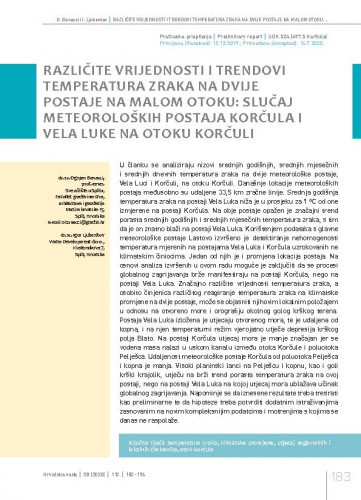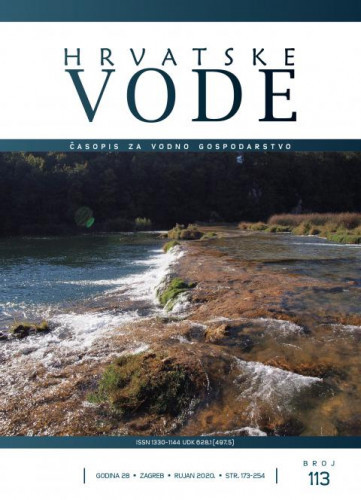U članku se analiziraju nizovi srednjih godišnjih, srednjih mjesečnih i srednjih dnevnih temperatura zraka na dvije meteorološke postaje, Vela Luci i Korčuli,na otoku Korčuli. Današnje lokacije meteoroloških postaja međusobno su udaljene 33,5 km zračne linije. Srednja godišnja temperatura zraka na postaji Vela Luka niža je u prosjeku za 1 ºC od one izmjerene na postaji Korčula. Na obije postaje opažen je značajni trend porasta srednjih godišnjih i srednjih mjesečnih temperatura zraka s tim da je on znatno blaži na postaji Vela Luka. Korištenjem podataka s glavne meteorološke postaje Lastovo izvršeno je detektiranje nehomogenosti temperatura mjerenih na postajama Vela Luka i Korčula uzrokovanih ne klimatskim činiocima. Jedan od njih je i promjena lokacija postaja. Na osnovi analiza izvršenih u ovom radu moguće je zaključiti da se procesi globalnog zagrijavanja brže manifestiraju na postaji Korčula nego na postaji Vela Luka. Značajno različite vrijednosti temperatura zraka, a osobito činjenica različitog reagiranje temperatura zraka na klimatske promjene na dvije postaje može se objasniti njihovim lokalnim položajem u odnosu na otvoreno more i orografiju okolnog golog krškog terena. Postaja Vela Luka izložena je utjecaju otvorenog mora te je udaljena od kopna i na njen temperaturni režim vjerojatno utječe depresija krškog polja Blato. Na postaji Korčula utjecaj mora je manje značajan jer se vodena masa nalazi u uskom kanalu između otoka Korčule i poluotoka Pelješca. Udaljenost meteorološke postaje Korčula od poluotoka Pelješca i kopna je manja. Visoki planinski lanci na Pelješcu i kopnu kao i gole krški krajolik utječu na brži trend porasta temperatura zraka na ovoj postaji nego na postaji Vela Luka na kojoj utjecaj mora ublažava učinak globalnog zagrijavanja. Napominje se da iznesene rezultate treba tretirati kao preliminarne te da hipoteze treba potvrditi dodatnim istraživanjima zasnovanim na novim kompleksnijim podacima i motrenjima s kojima se danas ne raspolaže.. The paper contains the analysis of the series of mean annual, mean monthly and mean daily air temperatures at two meteorological stations, Vela Luka and Korčula, on Korčula Island. The present locations of the meteorological stations are 33.5 km apart (as the crow flies). The mean annual air temperature at the Vela Luka station is on average 1 ºC lower than the one measured at the Korčula station. At both stations, a significant trend of increase in mean annual and mean monthly air temperatures has been observed, although it is significantly milder at the Vela Luka station. Using data from the main meteorological station Lastovo, the inhomogeneity of temperatures measured at the stations Vela Luka and Korčula resulting from non-climatic factors, one being the change in the locations of the stations, has been detected. Based on the analyses conducted in the paper, a conclusion can be drawn that global warming processes manifest faster at the Korčula station than at the Vela Luka station. Significantly different air temperature values and especially the fact that air temperatures respond differently to climate change at the two stations can be explained by their local position relative to the open sea and the orography of the surrounding bare karst terrain. The Vela Luka station is exposed to the influence of the open sea, it is far from the mainland and its temperature regime is probably affected by the depression of the karst field Blato. At the Korčula station, the influence of the sea is less significant because the water mass is located in the narrow channel between Korčula Island and the Pelješac peninsula. The distance of the Korčula meteorological station from the Pelješac peninsula and the mainland is smaller. The high mountain ranges of the Pelješac peninsula and the mainland, including the bare karst landscape, influence the faster trend of air temperature increase at this station compared to the Vela Luka station, where the impact of the sea mitigates the effect of global warming. It is of note that the presented results should be treated as preliminary results, and that the hypotheses should be confirmed by additional investigations based on new, more complex data and monitoring that are unavailable today..
Sažetak
Dio sveska

